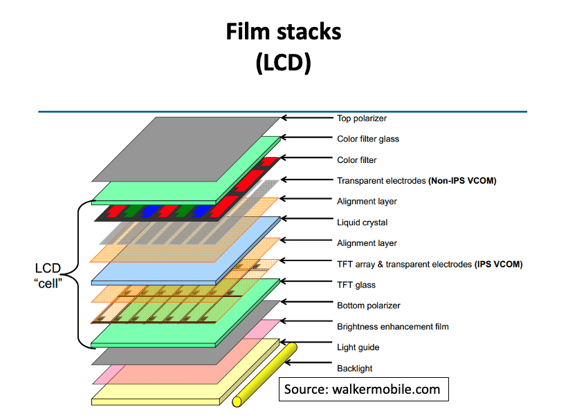Non-Contact Measurement Supports Growth in Consumer Electronics Market
The demand for touchscreen technology continues to outstrip supply—this is a trend that shows no sign of waning as 2022 gets underway. Recent market statistics published by Counterpoint show that shipments of cell phones in the U.S. market have grown 27% despite shortages in raw materials including silicon chips which are key components for their production.
Two other critical market constraints placing downward pressure on production capabilities for smartphones include:
- poor accuracy in the quality assurance process, leading to reduced throughput and output.
- lack of quality measurement methodologies due to waste and reduced throughput. As liquid crystal display (LCD) touchscreen technology advances, so do consumer expectations for the quality and durability of their devices.
As such, manufacturers face mounting pressure to ensure that the layer stacks are uniform. This makes reducing any production deficiencies key to both the ability to meet market demand and satisfaction. An important development to support this goal is the use of white light interferometry to perform highly accurate non-contact thickness measurements.
Layers Within Touchscreens
Touchscreens for tablets, smartphones, and computers generally consist of two independent modules: the imaging display and the touch module, with the latter placed on top of the display. The imaging display creates the image, while the touch module allows the user to interact with the device.
The most commonly used type of imaging display is the liquid‐crystal display or LCD. The light from a backlight source is distributed throughout the screen by a layer of a diffuser (a light guide with a brightness enhancement film). The light then passes the first polarizer and travels through a layer containing liquid crystals sandwiched between two layers of electrodes. The liquid crystals are activated by the electric signal. In the case of the active matrix display, the bottom electrode layer consists of an array of thin‐film‐transistors located on a substrate.
How Can You Boost Production Levels?The OptiGauge II helps increase production throughputs and reduces costs associated with consumer electronics manufacturing. |
Similar to imaging displays, there are a variety of touchscreen technologies on the market. The most common touchscreen technology is capacitive, which is based on detecting the change in the capacitance between two arrays of electrodes when the human finger approaches the surface of the screen.
The different components of these displays and touchscreens must be consolidated into one unit. This is done by manufacturers using a layer of adhesive, the uniformity of which can be difficult to control during the production process.
The Role of Low‐Coherence Interferometry
To control the thickness of the adhesive layer during the manufacturing process, the manufacturer must be able to measure the thickness of the layer during or after the manufacturing process. Conventional mechanical methods of measurement require the destruction of the finished product. This increases waste and adds significant cost to manufacturing because large batches of products must be discarded especially when this problem is not detected promptly.
Optical non-destructive measurement addresses this issue by allowing 100% inspection, on‐ or at‐line, in real-time. This is the ideal application of low‐coherence interferometry. The light from a low‐coherence light source is split into two portions. These two portions form sample and reference interferometric arms. The sample portion of the light illuminates the layer stack of a touchscreen or some other device. Each surface within the layer stack reflects the incident light. The reflected light is then combined with the reference portion of the light. The combined light creates an interferometric pattern.
However, in the case of the low-coherence light source, the interferometric pattern is visible only under certain conditions, when the path traveled by the light in the sample arm of the interferometer (to and from the corresponding sample interface) is equal to the path in the reference arm of the interferometer. By varying the length of the reference arm of the interferometer, and by measuring the magnitude of the change between the locations where the interferometric pattern appears, one can extract the distances between the reflective interfaces within the sample, i.e. the layer thicknesses.
Using this non-contact measurement technology, the layer thicknesses in the touchscreens can be measured within a continuous scan, instead of at a single point. To obtain thickness variation along with the scan, the screen (or the optical probe) is moved along the predetermined path, while the thickness of the layers is being continuously measured. This scan identifies significant inconsistencies in the manufacturing process that cannot be seen with a naked eye, and cannot be directly measured by any mechanical means.
Low‐coherence interferometry instruments provide a clear advantage over mechanical measurement methods as discussed above. Lumetrics’ commercially available OptiGauge II is based on time-domain interferometry and serves as a comprehensive, practical tool for non‐destructive product metrology and quality control during and after the manufacturing process which enables manufacturers of consumer electronics and their components to increase production, reduce waste, and ultimately, meet the demand to maximize their growth.
To learn more, download the Lumetrics whitepaper:
Measurement of Film Stacks in Cell Phones and Tablets Using White Light Interferometry.
Need help maximizing your production output? Talk to an engineer to see how interferometry can work for you.

